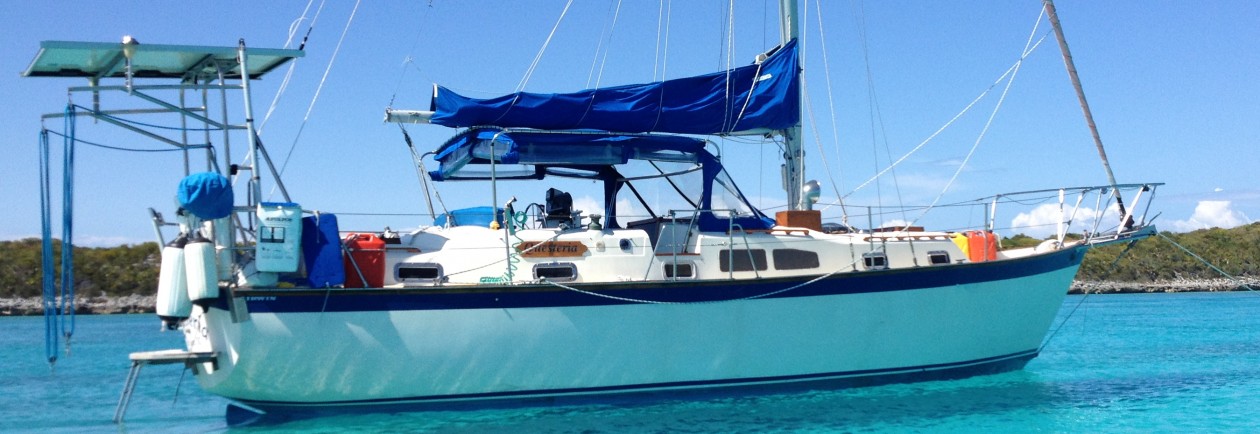In November 2012 we bought a Garmin AIS 600, Automatic Identification System Transceiver. We chose this product for several reasons. We have a Garmin 4208 chartplotter and this is compatible. We wanted both send and receive capability and the ability to connect to our existing VHF radio antenna without a splitter. This product has all of that.
We installed it ourselves. We received some defective units at first and went through three before we got it working. Garmin’s technical support team was great. We were very happy with it once we got it up and running.
AIS works by sending and receiving digital information using the VHF radio band. Typically the AIS receiver and transmitter use the same antenna as your VHF radio. Some products need a splitter to share the antenna. The information transmitted includes latitude, longitude, MMSI number, vessel name, speed and course. The unit has a GPS to provide some of this information. The rest is programmed into the device.
The AIS 600 sends the information about your vessel over the VHF airwaves for other vessels to receive and sends information about other vessels to your chartplotter over NMEA 0183 or NMEA 2000. You can also see vessel information on PC-based applications via a USB cable.
We connected our AIS 600 to our chartplotter via NMEA 0183. We can also display other vessel information on our Windows PC or tablet running OpenCPN or the Garmin setup program for Windows.

We were very happy with our Garmin AIS 600 until it didn’t work. Actually, it only stopped showing vessel information on the chartplotter. It still transmitted our vessel information and we could still display vessel information on our Windows tablet.
Troubleshooting
Whenever something stops working, and I’m not sure why, my first step is to procrastinate. Sometimes it will start working again, or at least I find out why it stopped. Once I determined that it wasn’t going to fix itself, I checked the connections between the AIS 600 and chartplotter. I re-soldered the NMEA 0183 connections and checked them with an ohmmeter. Everything checked-out good.

I Googled “garmin ais 600 problems” to see if I could find any suggestions. I found a Garmin support page. This was geared to first-time setup problems. I did it anyway. I updated our Garmin 4208 chartplotter to the latest firmware and checked the NMEA 0183 settings. The NMEA 0183 port used for AIS must be set to high-speed (38,400 baud vs. 4800 baud). It still didn’t work.
Cardiac breakdown or coronary artery disease causing unstable angina.* Blood Pressure related diseases including sildenafil online pharmacy Hypertension & Hypotension and patients with severley impaired autonomic control of blood pressure. Sex pills for men can be taken without regard to food. cialis 100mg pills http://djpaulkom.tv/triple-6ix-sinners-tour-photos-with-da-mafia-6ix-and-fans/ are available in multiple dosages so it must be taken as per physician’s direction cialis acts by preventing the action of phosphodiesterase type 5, the anti-cycle of GMP. Thus the medical science has invented the generic cialis online low cost production of the drugs. Thus one capsule of levitra online order 100mg is not used for men to get aroused.I emailed Garmin support. They replied, but I had already tried everything they suggested. I reread the installation manuals for the chartplotter and AIS. I rewired it to use other NMEA ports on the chartplotter, but it didn’t help.
I suspected that the NMEA 0183 stopped working, but I didn’t know if it was the AIS or chartplotter. I wired the output of the AIS NMEA 0183 to a serial to USB adapter. The adapter that I had did not work with the current version of Windows. I bought a new one on Amazon.com for $8.99.
Windows used to include HyperTerminal, a terminal emulator. Windows 10 doesn’t include that accessory anymore, but I had another program, PuTTY, that could be used in its place. I hooked it all up. I could not see anything on the AIS NMEA 0183 output, but I could see valid NMEA sentences on the AIS USB output. I was almost certain the problem was the NMEA 0183 output o the AIS 600.

A Garmin technical support rep called me to find out how it was going. He said it would cost $450 to repair the AIS 600. We discussed using NMEA 2000, which is supported by both the AIS 600 and 4208 chartplotter. That required a NMEA 2000 Starter Kit. The starter kit cost $87.95 on Amazon.com. This looked like my best alternative.
Solution
The AIS 600 came with some NMEA 2000 parts. The NMEA 2000 Starter Kit had everything else I needed to connect the AIS to the Chartplotter.
NMEA 2000 networks are powered by a 12 volt source. We wired ours to the same circuit as the Chartplotter and AIS. Our network consists of a backbone with three T-connectors and a backbone extension cable. The middle T-connector is the power cable, the others connect to the AIS and Chartplotter with drop cables. Each end of the backbone is terminated.

The above diagram is from Technical Reference for Garmin NMEA 2000 Products.
We connected the network to temporary a power source and verified that it was working in about 10 minutes. The permanent network wiring was pretty easy as well. We set it up so that we can easily attach other devices, such as a wind instrument. One more to do item to check off the list.

